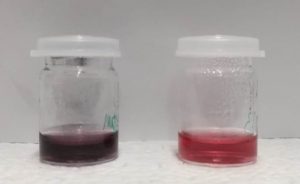Nanomedicine represents the field of research that deals with the integration of nanotechnology in medical application. Main topics in nanomedicine are the use of nanomaterials for advanced drug delivery systems, new therapies and imaging.
Among the nanoparticles of interest for nanomedical applications, gold nanoparticles are definitely one of the most investigated. The reason behind such great interest is linked to several attractive features that these particles exhibit, combined with the proved low toxicity.
Au nanoparticles are characterized by peculiar optical properties: when they are illuminated, conduction band electrons on their surface are delocalized and undergo collective oscillation at the same frequency as the incident light. This phenomenon known as Localised Surface Plasmon Resonance (LSPR) is responsible for absorption and scattering of light, which can lead to heating or facilitate nanoparticle detection, even by naked eye.

Figure 1: Golden nanoparticles with different optical properties
Gold nanoparticles optical properties are affected by particle size, shape and chemical environment: interaction with specific compounds can induce, for instance, aggregation of the nanoparticles, inducing changes in the optical properties, making these particles attractive as biosensors components. Gold nanoparticles find significant applications in lateral flow assays, where the particles are conjugated with recognition markers such as antibodies, and implemented in paper-based devices, offering diagnostics tools, through simple naked eye observation, for the detection of viruses, bacteria, proteins, drugs, toxins, etc. Similarly, by conjugating gold nanoparticles with molecules that bind to cells, the mentioned optical properties can be employed for cellular imaging. Gold nanoparticles find applications also in other imaging modalities, such as X-Ray CT imaging (enhancing X-ray attenutation) and PET imaging (by functionalization with radionucleotides).
The SPR properties are also employed for photothermal cancer therapy: gold nanoparticles can absorb and convert the photon energy into thermal energy when a laser beam irradiates them in the SPR wavelength. Photothermal heating only occurs in the area directly surrounding the nanoparticles, enabling targeted heating, hence locally damaging the tissue to which they bind. Hence, through proper particle functionalization, gold nanoparticles can bind to cancerous tissue, and via laser irradiation cause its overheating, and consequent damaging. Photothermal heating properties also makes these particles interesting for triggered drug delivery applications, for example employing organic-inorganic architectures based on gold nanoparticles and thermoresponsive gels loaded with drugs. These gels exhibit swelling-deswelling behaviour dependent on temperature: when heated, these polymers shrink, enabling faster release of the drug they were loaded with. Hence, when these gels are combined with gold nanoparticles, the particles can be heated up via laser heating, enabling on-off drug release.
These attractive properties, that makes gold nanoparticles so interesting for nanomedical application, are strongly influenced by particles size and shape: an efficient implementation of these nanoparticles in medicine requires the development of highly controlled synthetic processes, enabling good control over the particle size and shape, as well as enhanced reproducibility of the synthesis product. For these reasons, moving the synthesis of gold nanoparticles from batch to continuous reactors is a challenge that we must face, for better human health.
Luca Panariello, UCL




